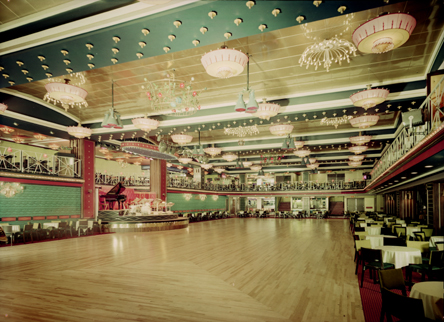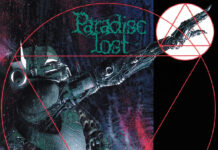Countless books, articles, and essays on the mythic kings of atomic blues better known as Led Zeppelin have been compiled and written these past many decades, which undoubtedly underlines and emphasises just how influential the group truly was, and very much still is. This painfully short article focuses on the importance of the legendary and now-demolished Mayfair Ballroom in the great city of Newcastle upon Tyne and why this hallowed place plays a vital role in Zeppelin lore as well as rock music discourse in North East England in a more general perspective. Exhaustive or in-depth it is not, but if it raises a bit of awareness as to the aforementioned venue’s significance to Zeppelin’s early years, or simply makes you curious with respect to rock music history in that corner of the world, and then compels you to take a peek at the site the next time you find yourself wandering the streets of my favourite city, then my goal has been accomplished. While there is nothing decidedly new about this little creative endeavour of mine in the sense that no revolutionary findings are present in the text, it will hopefully serve as a reminder of just how vital Newcastle’s role in arts and culture is (regardless of genre and decade).
The Mayfair Ballroom opened in September of 1961 and functioned as a venue, dance hall, and (not surprisingly) an actual ballroom until its closure in 1999 when it was demolished to pave the way for the modern architectural monstrosity known as The Gate, which is a leisure and entertainment complex in the city centre, and it also serves as a car park. As David Morton wrote in his article for Chronicle Live:
Located on the corner of Newcastle’s Low Friar Street and Newgate Street, the Mayfair Ballroom during its lifetime would play host to ballroom dancing, staff parties, North East clubland concerts, disco nights, bingo, hairdressing competitions, rotary events, beauty contests, raves and, perhaps most notably, a lengthy list of A-list rock concerts . . . the venue began life as a traditional ballroom.
David Morton – Chronicle Live
The long-gone ballroom had a relatively lavish design and openly displayed a sense of class and style judging by the many photos that are available online – at least in comparison to many similar-sized clubs and venues dating from the sixties. There was a balcony that went all around the room, and on top of that, it also prided itself on having a revolving stage, which sounds rather sophisticated, but according to Ray Laidlaw the “revolving stage meant you couldn’t put your gear on stage until just before you were about to go on. There wasn’t room. The corridors backstage were full of gear” (Ravendale). On a busy night, it would hold approximately 2500 people. As stated on the excellent and informative Ready Steady Gone website:
The entrance to the Mayfair was on the corner of Newgate Street and Low Friar Street . . . The foyer was on street level but most of the premises were below ground level. It had an oblong-shaped ballroom with a large balcony that went all around the room. There were several bars with seating areas on the balcony plus more bars downstairs in the areas surrounding the large dance floor.
Ready Steady Gone
Numerous renowned and brilliant acts visited the venue during its existence, some of which included The Nice, The Who, Queen, AC/DC, Iron Maiden, Metallica, The Clash, and Judas Priest among others. Another way of phrasing that would be to simply state that some of the best and most influential bands on the planet graced the Mayfair stage at some point. If you were a regular there back in the 60s then most likely you would have enjoyed The Graham Bond Organization, proto-proggers the Moody Blues, the post-Syd Barrett version of Pink Floyd, the psychedelic geniuses that are The Zombies, none other than Deep Purple, the hellfire-raising The Crazy World of Arthur Brown, and so many others who have spearheaded and crafted the styles and flavours of rock and metal that we love and cherish. Did I mention that Ozzy Osbourne, UFO, The Jam, Hawkwind, Ramones, Thin Lizzy, Wishbone Ash, Tygers of Pan Tang, Nirvana, Slade, and the greatest of them all, namely Black Sabbath, also performed there? In short, an abundance of rock royalty laid down their grooves on the stage of the Mayfair Ballroom, but its main claim to fame is unarguably that it played host to Zeppelin’s British live debut on October 4, 1968.

Jimmy Page, Robert Plant, John Bonham, and John Paul Jones, arrived in Newcastle Upon Tyne on either October 3, i.e. the day before their show at the Mayfair, or on the same day as they were scheduled to appear at the ballroom. Interestingly, they were billed as “The Yardbirds featuring Jimmy Page” (Lewis and Tremaglio, 39). However, there seems to have been a somewhat fluent transition taking place concerning the collective name of the hard-hitting ensemble. Author Martin Power states that “Some dates were played under the name the Yardbirds, some as the New Yardbirds, then as Led Zeppelin. Their first gig on British soil was on October 4 at Newcastle’s Mayfair ballroom as the New Yardbirds, supported by local act the Junco Partners” (183). Even more curious is the fact that advertisements for the Newcastle performance sported the moniker “The Yardbirds (Featuring Jimmy Page) whereas a ticket stub read “The Yardbirds” in addition to listing the support acts, more specifically Terry Reid’s Fantasia, Downtown Faction, and the aforementioned Junco Partners. According to Zeppelin historians Dave Lewis and Mike Tremaglio, Terry Reid’s Fantasia cancelled their appearance and were replaced by New York Public Library:
The very first concert performed in England by Page, Plant, Jones & Bonham (advertised in the Evening Chronicle as “The Yardbirds featuring Jimmy Page”). Ironically enough, singer Terry Reid, who turned down Jimmy Page’s offer to join the band earlier in the year, was originally slated to be on the bill, but had to cancel out. (39)
Now, the way I envision the gig is that the four gentlemen took command of the stage, played a blinding and blistering set, beguiled and pulverized the audience, and appeared like a fully formed group capable of conjuring up a primordial force, unlike anything the crowd had ever witnessed previously. Then again, that is merely how things play out in my mind when I try to imagine what it must have felt like to witness such a pivotal event. On the other hand, the Zeppelin performance could have been poorly attended or simply lacklustre, but the truth is that none of that would have mattered or even remotely depreciated the cultural and historical value of the concert and its role in the overall Zeppelin saga. Since I am prone to romanticising things, I would very much like to believe that it was an awe-inspiring night in the company of a kick-ass ensemble destined for stratospheric fame. Having said that, Ready Steady Gone paints a less-than-flattering portrait of this otherwise crucial and historically important date and sheds a different light on it:
The Yardbirds, featuring vocalist Keith Relf and guitarist Jimmy Page had actually broken up in July 1968. Because the Yardbirds were due to tour Scandinavia, Keith Relf allowed Jimmy Page to put together a band to fulfill the Yardbirds’ outstanding commitments. Page formed the ‘New Yardbirds’, which featured himself, Robert Plant, John Bonham and John Paul Jones. People who went to see the Yardbirds and Terry Reid on 4th October may have been disappointed. The New Yardbirds (albeit advertised as just the ‘Yardbirds’) had only one member of the former Yardbirds – Jimmy Page . . . By all accounts the Mayfair wasn’t very full that night.
Ready Steady Gone
Considering the above I am quite obviously guilty of romanticising Zeppelin’s – no doubt about that – but on the other hand, the esteemed Classic Rock recently published an online article that focuses on Zeppelin’s “birth” at the Mayfair Ballroom, and it does make for a great read that comes highly recommended. People went away with vastly different impressions of Page and his cohorts’ demonstration of how to conjure up some fiery demonic blues rock. Ray Laidlaw mentions that “I don’t recall the gig being that well attended. The Yardbirds were old news by that point” and that “They didn’t have a presence; There was no chemistry” (Ravendale). At the other end of the spectrum, we have Charlie Foskett emphasising just how good and exciting the band sounded that night:
After five minutes it was: “This is great!”. Everybody had forgotten about The Yardbirds. Nobody knew the name Led Zeppelin then, of course, so it was: “Yeah, this is the New Yardbirds!” . . . I thought the band were terrific. The first thing was the energy. Everything was a bunch of riffs. Page’s guitar was ripping away. I’ve heard better soloists, but he was a great showman, a walking skeleton with skin-tight bell-bottom jeans, the hair and tons of posing. (ibid)
Perhaps the most thought-provoking and tragically hilarious comment is provided by record dealer John Porteous who says that a friend of his went to the front desk after a handful of songs and demanded his money back due to the band on stage not being the Yardbirds and that “Quite a few others did the same” (ibid). In the clear retrospective gaze of history, those people were missing out on the beginning of something magical, but hindsight is always 20/20, right? On the other hand, Fraser Suffield who worked at the Mayfair remembers things differently and states, “I didn’t receive any complaints from the Mayfair manager about people wanting their money back. When people were leaving I got no adverse comments about them not being the band they were expecting” (ibid). As I said, the article by Classic Rock’s Ian Ravendale is a marvellous read and worth examining.
Walking past the blue plague that marks the spot where the Mayfair Ballroom once was fills me with a sense of wonder and reverence; not only was this where Led Zeppelin’s first gig in the UK took place but it also welcomed and cherished some of the most inspired and inspiring bands and artists known to man. Can you imagine what it must have been like to have been an avid fan of rock music in Newcastle from the late sixties when Fleetwood Mac stopped by until Motörhead damn-near demolished the place singlehandedly in late 1998 (roughly six months before the Mayfair’s closure) when they were bringing their No Speak with Forked Tongue tour to the masses? There may not be a single trace of the impressive venue left to the visible eye these days, but the memory of the place lives on in the minds of those who were fortunate enough to see and hear the most vigorous and life-affirming sounds of the known universe being evoked on the humble stage of the Mayfair Ballroom – not least those who witnessed history in the making on that significant day in the fall of 1968 when Led Zeppelin were in town.
Works cited:
- Lewis, Dave & Mike Tremaglio. Evenings with Led Zeppelin: The Complete Concert Chronicle. Omnibus Press, 2018.
- Morton, David. “Newcastle’s Mayfair Ballroom – how the legendary venue was born 60 years ago.” Chronicle Live. 13 Sept. 2021, https://www.chroniclelive.co.uk/news/history/gallery/newcastles-mayfair-ballroom-how-legendary-21555254. Accessed 3 Nov. 2024.
- Power, Martin. No Quarter: The Three Lives of Jimmy Page. Omnibus Press, 2016.
- Ravendale, Ian. “Behind the scenes at Led Zeppelin’s first UK show, told by the people who saw it.” Classic Rock. 30 Aug. 2024, https://www.loudersound.com/features/led-zeppelin-uk-debut. Accessed 16 Sept. 2024.
- Smith, Roger. “Mayfair Ballroom.” Ready Steady Gone! Gigging in the North East 1965-1972. A Personal Perspective by Roger Smith. 14 July 2010, https://readysteadygone.co.uk/mayfair-ballroom-2/. Accessed 5 Oct. 2024.
























